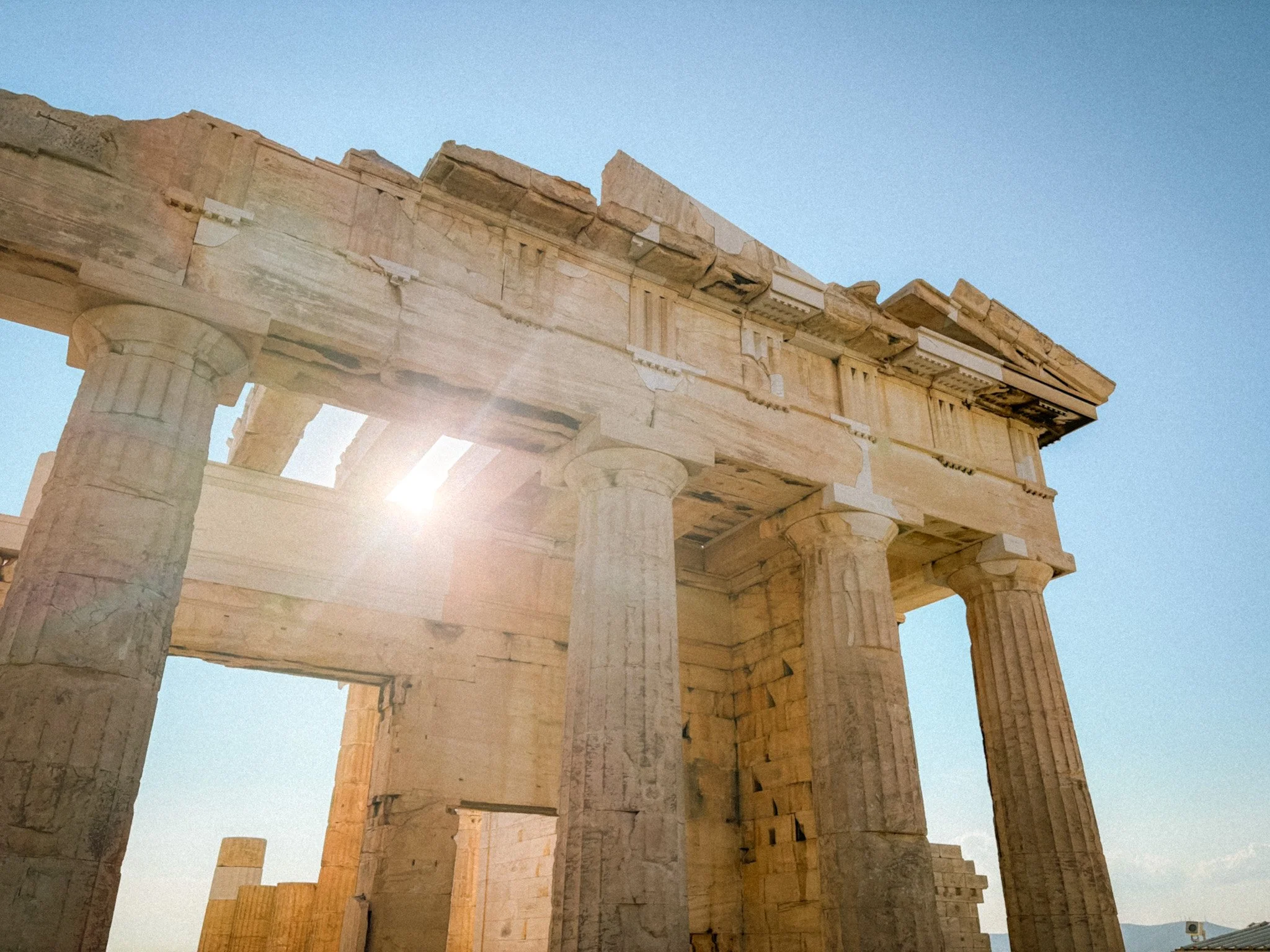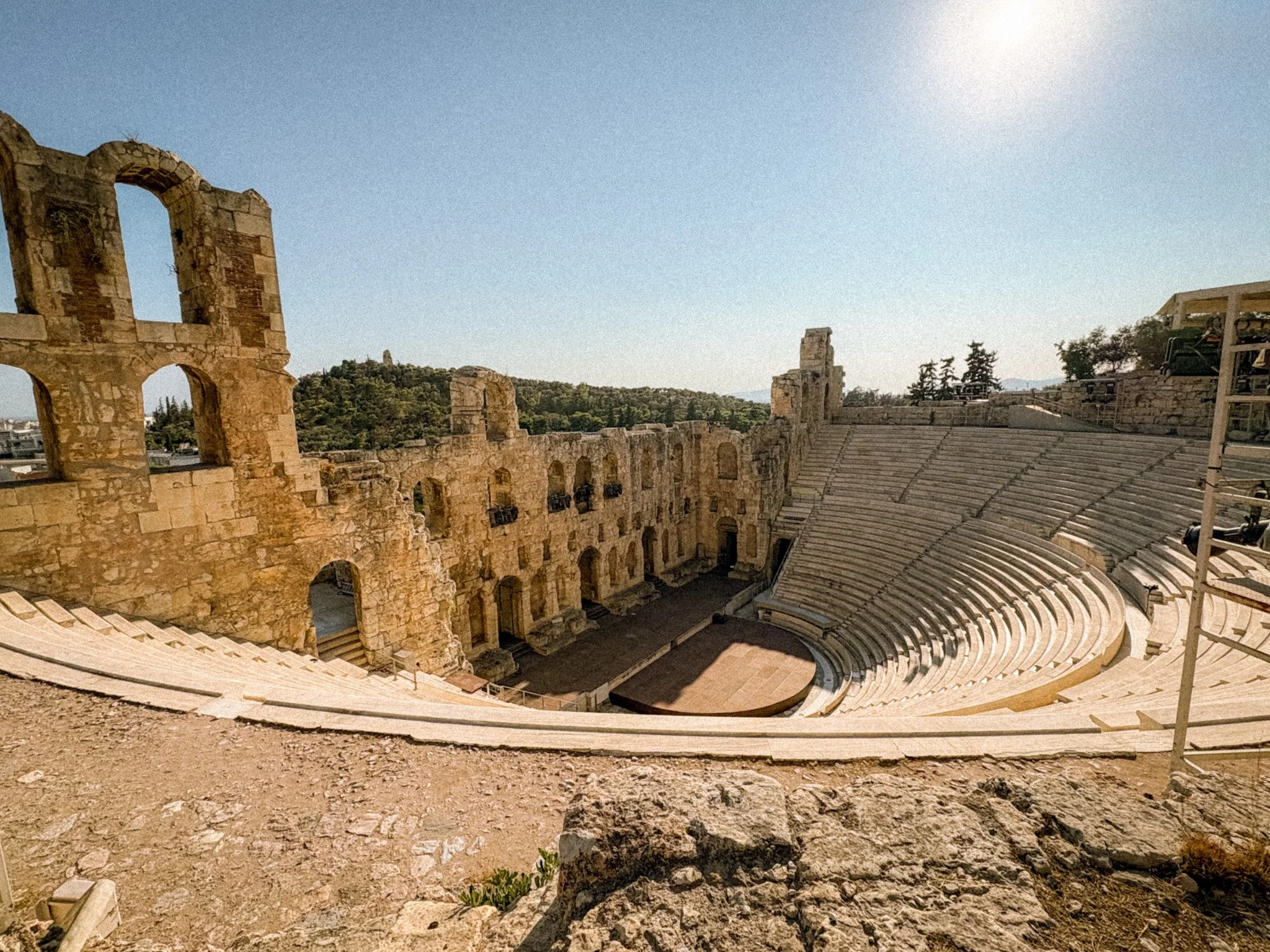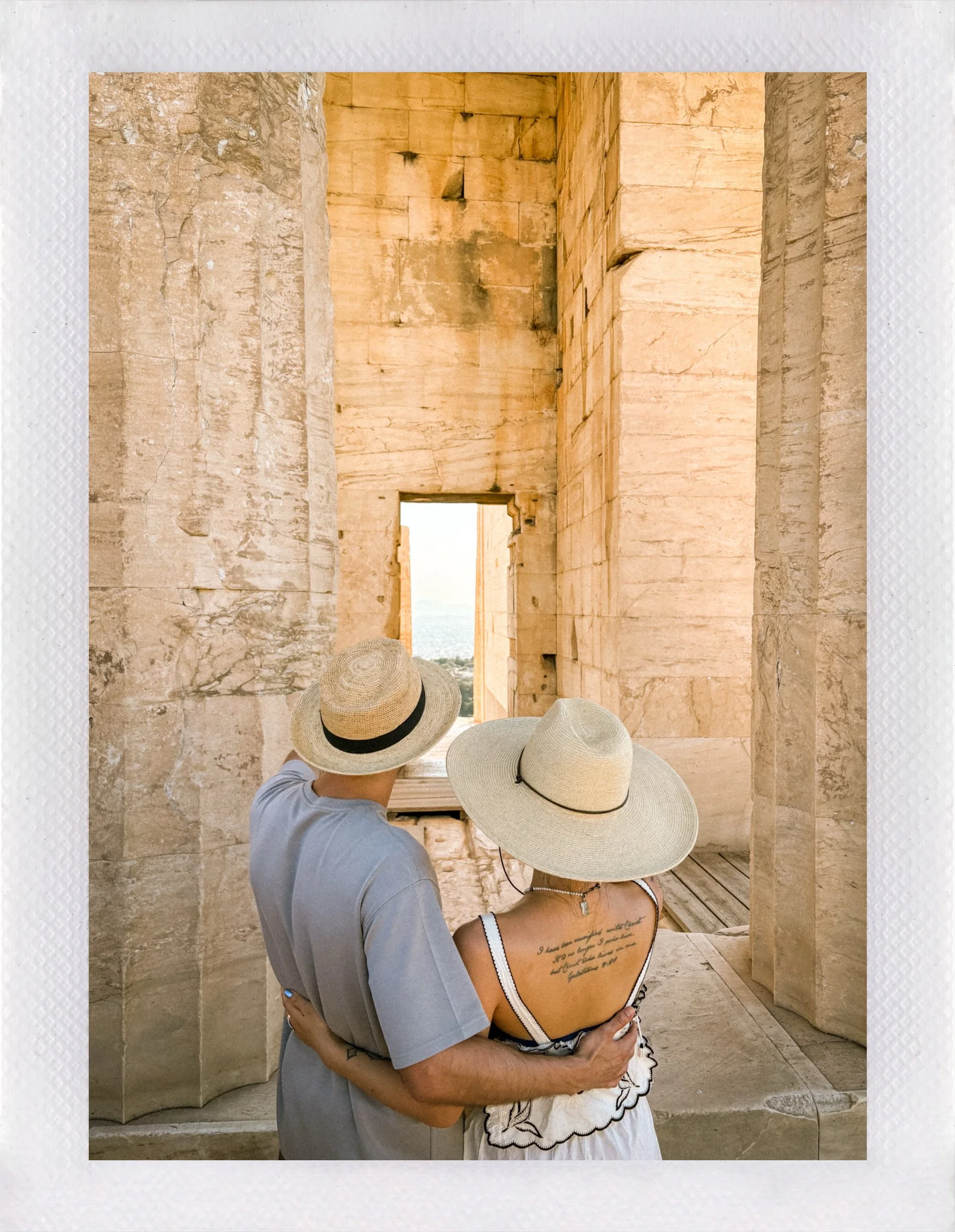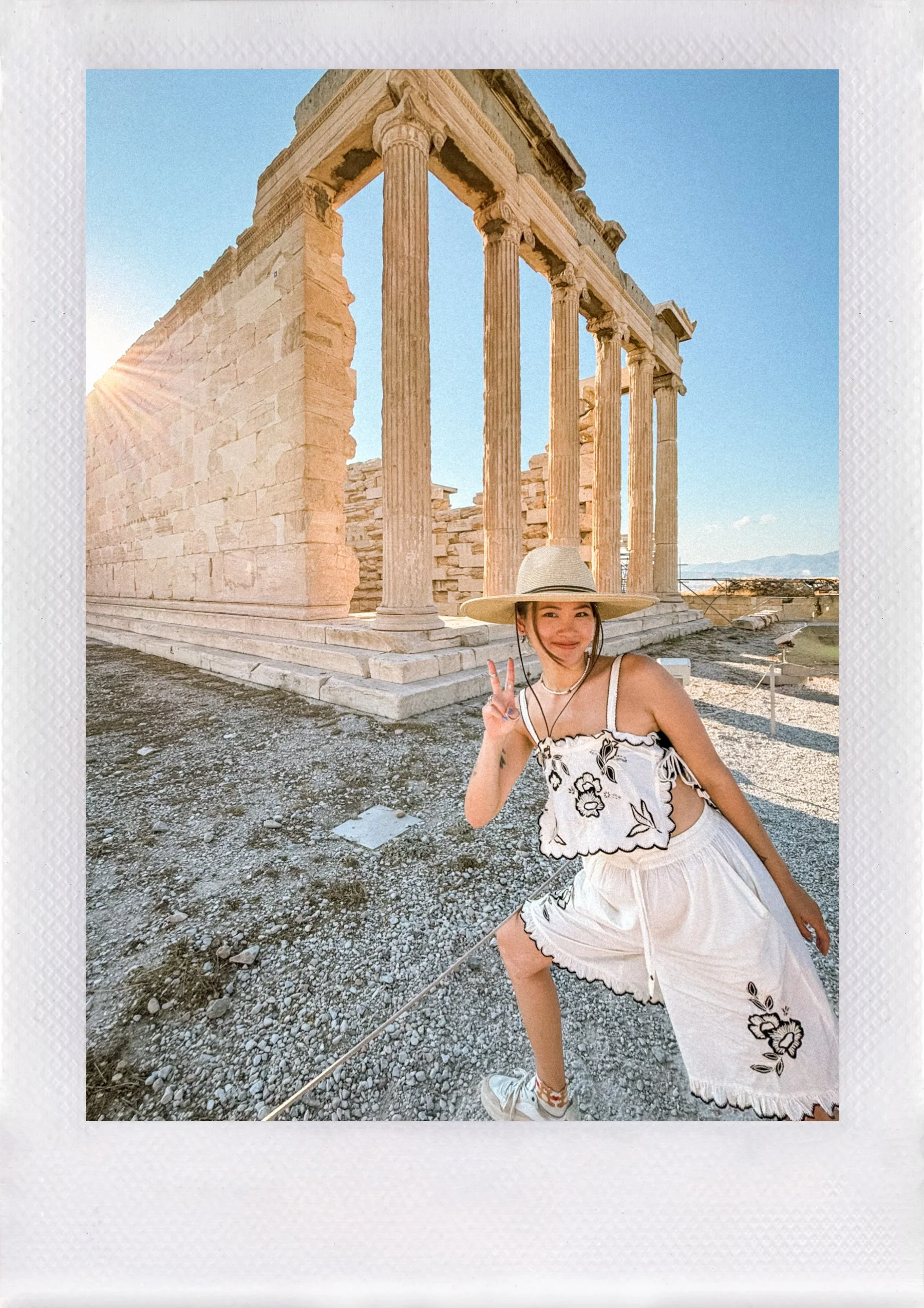【Ακρόπολη Αθηνών】The Acropolis in Athens, Greece
Viewing the Parthenon in early August (tons of people all around)
This post contains affiliate links, meaning EVERLASTYING will earn a commission if you purchase through our link at no extra cost.
Read my disclosure for more information. I appreciate your support 🤍
Rising high above Athens, the Acropolis is more than just a historic archaeological site — it’s the symbol of Greece. Built over 2,500 years ago on a limestone plateau, this sacred citadel was dedicated to the goddess Athena and has survived wars, bombing, and foreign rule — only to remain one of the most awe-inspiring landmarks in the world.
Over time, the Acropolis has undergone numerous transformations — from a temple complex to a fortress, a church, and even a mosque — yet it still stands proudly as the heart of ancient Greek civilization.
After visiting Athens myself, I’ve gathered insider tips, time-saving hacks, and stress-free ways to explore both the Acropolis and the Acropolis Museum so you can save time and money.
💸 SMART MOVE
Book a skip-the-line combo ticket via GetYourGuide — it saves hours in line (especially during summer crowds) and usually costs less than buying separately.
about the Acropolis
The Acropolis is an ancient citadel perched on Athens’ highest hill, home to the Parthenon and several other temples of immense architectural and historical significance. The word Acropolis comes from the Greek akron (“highest point”) and polis (“city”). In ancient times, it was also called Cecropia, named after Athens’ first mythical king, Cecrops, who was a half-man, half-serpent figure.
Archaeological evidence suggests that people lived on the hill as early as 6000 BC, when it served as a Mycenaean palace known as the Megaron. The only traces that remain today are the limestone bases and sandstone steps.
By the 7th–6th centuries BC, Athens faced political instability. The tyrant Peisistratos and his sons later restored order and sponsored major building projects, shaping the early Acropolis with new gates (Propylea), fortified walls, and the Clepsydra spring enclosure.
As the sacred ground of Athena, Athens’ patron goddess, the Acropolis saw its first major temples:
Hekatompedon (ca. 570–550 BC), nicknamed “Bluebeard Temple,” an early Doric limestone shrine.
Old Temple of Athena Polias (ca. 529–520 BC), which was later destroyed by the Persians in 480 BC when they burned Athens.
Athenians soon began building a grander “Older Parthenon” on a marble foundation of over 8,000 limestone blocks — but the Persians destroyed it again in 480 BC. Instead of erasing the past, the Athenians embedded fragments of the ruined temples into the North Wall as a memorial of resilience.
Centuries later, archaeologists uncovered this “Persian Debris” (also known as Perserschutt in German), one of the richest archaeological finds on the Acropolis. Many of these artifacts are now displayed in the Acropolis Museum.
After defeating the Persians at Eurymedon (468 BC), Athens entered its Golden Age under Pericles. Architects Ictinus and Callicrates, led artistically by Phidias, built the Parthenon and other marble masterpieces we see today.
Through time, the Acropolis evolved:
Roman era – Temples to Roma and Augustus were added; Herodes Atticus built the Odeon amphitheater (161 AD).
Byzantine period – Parthenon became a church to the Virgin Mary.
Frankish rule – Turned into a cathedral and palace with a tower.
Ottoman period – Became a mosque; Propylaea served as garrison HQ.
1687 – A Venetian cannon struck the Parthenon, igniting Turkish gunpowder and causing massive damage.
Parthenon from another angle
Greece reclaimed the Acropolis in the 1820s, stripping later additions to restore its classical form. During WWII, Nazis raised their flag over the hill until two Greek teenagers who were 19 at the time, Manolis Glezo and Apostolos Santas, tore it down — an act of resistance that inspired Europe.
Today, the Acropolis welcomes millions annually (over 8 million in 2023!!!). To protect it, visitor numbers are capped at 20,000 per day.
Opened in 2009, the Acropolis Museum showcases treasures like the Caryatid originals and Parthenon marbles — a must-see for anyone visiting Athens.
Acropolis vs. Acropolis Museum
So you’re probably wondering… what’s the difference between the two?
The Acropolis is the actual archaeological site — located at the top of a rocky hill in Athens, home to temples like the Parthenon, Erechtheion, and Temple of Athena Nike.
The Acropolis Museum, on the other hand, is a sleek, modern museum (opened in 2009) that houses all the original artifacts from the Acropolis — including sculptures, “Persian debris,” and treasures uncovered during excavations.
➪ You can visit both on the same day: start early at the Acropolis (before it gets too hot, especially during the summer heatwave), then cool off inside the air-conditioned museum afterward.
💡PRO TIP: Buy a combo ticket on GetYourGuide to visit both — you’ll skip the line and save money versus buying two separate tickets.
getting to the Acropolis
Don’t stress about the logistics — both are conveniently located nearby. Here are some options:
🚇 METRO
Take Line 2 (Anthoupoli – Elliniko) and get off at Acropoli Station. It’s a short walk to both the site and the museum.
🚴♀️ BIKE
You’ll find bike racks at the Museum’s entrance on Dionysiou Areopagitou pedestrian street, and at the Acropoli Metro Station.
🚕 RIDES
FREENOW (like Uber) is the go-to app for Athens — reliable and with nicer rides.
UBER: You can still use Uber in Greece, but it’s not as common.
how to buy tickets
There are a few ways to secure your entry — but some can save you time, stress, and money.
1. Official Website
You can always buy tickets from the official website. Choose your time slot (required since April 2024), as only 20,000 visitors per day are allowed to protect the site.
General Admission: €30
Over 65 (EU): €15
Under 25 (EU): Free
Under 18 (non-EU): Free
2. Guided Tours
Skip the chaos and the lines with a small-group or private guided tour via GetYourGuide. You’ll be able to:
☑ Skip the lines (huge win during peak season)
☑ Hear insider stories + Greek mythology from your guide
☑ Visit both the Acropolis and Museum in one go = more bang for your buck!
3. Acropolis Museum Official Site
Tickets are €20, but hours vary by season and holidays — always check here. Some days are free entry, so it’s worth double-checking before booking.
highlights you can't miss
Each temple tells a different chapter of Athens’ story — here are the highlights you can’t miss:
Parthenon (447–432 BC)
Built during Pericles’ golden age from luminous Pentelic marble that gives off a golden hue under the sun, this temple was dedicated to Athena Parthenos. Inside once stood Phidias’ massive gold-and-ivory statue of Athena.
The Propylaea (437–432 BC)
Designed by the architect Mnesicles, this grand entrance to the Acropolis features a west-facing Doric façade and a painted gallery in the north wing (Polygnotus and others). The construction stopped in 431 BC due to the outbreak of the Peloponnesian War.
Temple of Athena Nike (421–409 BC)
A small Ionic temple perched just south of the Propylaea, celebrating Athena’s victories. This was completed during a brief period of peace in the Peloponnesian War.
Erechtheion (421–406 BC)
Known for its iconic Porch of the Caryatids (the six female statues as columns!), and also designed by the architect, Mnesikles. Inside, you’ll find sacred spots tied to both Athena and Poseidon.
The five original Caryatids (image above), the iconic female columns on the porch, Athena Polias, Poseidon-Erechtheus, Hephaestus, are now displayed at the Acropolis Museum — the sixth, Kore, still remains at the British Museum.
Odeon of Herodes Atticus
Built in 161 AD by Herodes Atticus in memory of his wife, Aspasia Annia Regilla. The theater was destroyed during the war and then rebuilt in the 1950s.
This amphitheater still hosts concerts today! (If you’re lucky, catch one while in Athens!)
Theater of Dionysis
The birthplace of Greek drama — imagine watching ancient plays right where it all began.
where to stay
Want to wake up to views of the Parthenon?
These hotels are conveniently located within walking distance and are perfect for exploring Athens.
Herodion Hotel (4⭐) – Perfectly located between the Acropolis and Museum. You can easily walk everywhere and have tons of food spots nearby.
InnAthens (4⭐) – Chic, modern, and tucked right in the Plaka neighborhood.
The Dolli at Acropolis (5⭐) – Boutique luxury at its finest, with only 46 rooms and jaw-dropping rooftop views.
Anthology of Athens (5⭐) – Sleek, modern design meets high-end comfort in the city center.
Find more hotels near the Acropolis
know before you go!
| CATEGORY | INFO |
|---|---|
| ADMISSION | Acropolis: €30 general, €15 seniors (EU), free for under 25 EU Museum<: €20, sometimes free on select days. |
| BEST TIME TO GO | April – May or September – October. If you’re visiting during the summer, go early in the morning to beat the heat and crowds. |
| LOCATION ETIQUETTE | No smoking, no climbing or touching the marble, and step aside if you’re stopping for photos or taking a break. |
| PERFECT FOR | History lovers. Architecture lovers. Culture seekers. Adventurous families. |
| PET POLICY | Not allowed |
| 🚻 FACILITIES | There are bathrooms inside the Acropolis Museum |
| PRICING | $$ |
| ⏱️ DURATION | 4–6 hours for both the Acropolis + Museum |
| WHAT TO WEAR | Comfy clothing, comfy shoes with a grip, a wide-brim hat, lots of sunscreen. |
| WHAT TO BRING | Hair tie. Water bottle. Sunscreen to reapply, especially during the summer, it gets super hot. |
| ♿ ACCESSIBLILITY | Some uneven terrain, but there’s an elevator on the side for wheelchair users. |
💸 PROP TIP: Upgrade to a skip-the-line Acropolis + Museum combo so you can move at your own pace and still see everything without overheating in line.
FAQ
-
Absolutely — start early at the Acropolis (especially if you’re visiting during the summer), then walk over to the Museum to browse and cool off, then grab lunch in the end.
-
Around 1 – 2 hours if you’re browsing quickly, or 2 – 3 hours if you love ancient history and art.
-
Not required, but totally worth it if you want to understand the stories behind what you’re seeing.
-
Partially. The terrain is rocky and uneven, so accessibility can be tricky.
To enter, you must reach the main entrance on the west side, where the ticket office and restrooms are located. The slope leading up (about 300 meters) is paved with ancient marble — it’s beautiful but uneven and slippery, especially after rain.
If you want to avoid the climb, taking a cab directly to the entrance gate is the easiest option. There are no parking spots available, so drivers will need to drop off and find parking nearby.
For access to the top, there’s an elevator on the north side.
-
Yes, but it’s better for adults or older kids — bring hats, sunscreen, and lots of water.
-
Sunscreen, reapply, and hydrate! There’s almost no shade, so bring a personal fan, a wide-brim hat, sunglasses, and a water bottle!
-
Acropolis of Athens: Disabled Accessibility for Acropolis and Museum
Acropolis Museum: The Erechtheion
Acropolis View Hotel: Discovering the Timeless Allure
Lonely Planet: A first-time guide to the Acropolis of Athens
Wikipedia: Acropolis
Wikipedia: Parthenon
final thoughts
It’s mind-blowing standing somewhere that’s been destroyed, rebuilt, and repurposed so many times — yet still feels ethereal. The climb is no joke (especially in summer 🫠), but that view from the top? Totally worth every sweaty step.
If you can, plan your visit in the spring or fall for cooler weather and smaller crowds. But honestly — no matter when you go, just go.
visit info
check out my Greece travel vlog!
DISCOVER MORE
08032025 12:21



















The mystical mountain of jagged peaks, monasteries, and views that’ll make you forget city life for a while. Whether you’re planning your first visit or deciding if it’s worth the trip, this Montserrat day trip guide has everything you need — from how to get there to the best time to visit and the tickets you don’t want to miss.